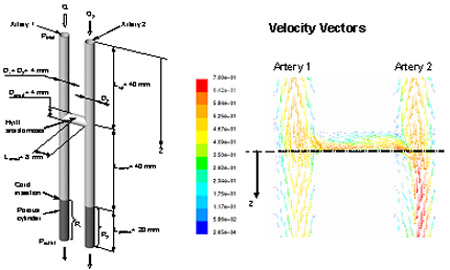

The Hyrtl anastomosis is a common connection between the umbilical arteries near the cord insertion in most human placentas. It was speculated that it equalizes the blood pressure between the territories supplied by the umbilical arteries. However, its functional role in the regulation and distribution of fetal blood flow to the placenta has not yet been explored. A computational model has been developed for quantitative analysis of hemodynamic characteristic of the Hyrtl anastomosis in cases of discordant blood flow in the umbilical arteries. Simulations were performed for cases of either increased placental resistance at the downstream end or reduced arterial blood flow due to some pathologies upstream of one of the arteries. The results indicated that when placental territories of one artery impose increased resistance to fetal blood flow, the Hyrtl anastomosis redistributes the blood flow into the second artery in order to reduce the large pressure gradients which are developed in the affected artery. When one of the arteries conducts a smaller blood flow into the placenta and a relatively smaller pressure gradient is developed, the Hyrtl anastomosis rebuilds the pressure gradients in the affected artery and redistributes blood flow from the unaffected artery to the affected one to improve placental perfusion. In conclusion, the Hyrtl anastomisis plays the role of either a safety valve or a pressure stabilizer between the umbilical arteries at the placental insertion.
Reference:
Gordon Z, Eytan O, Jaffa AJ, Elad D. Hemodynamic analysis of Hyrtl anastomosis in the human placenta. American Journal pf Physiology: Regulatory, Integrative and Comparative Physiology. 2006 (on-line, doi:10.1152/ajpregu.00410.2006).

